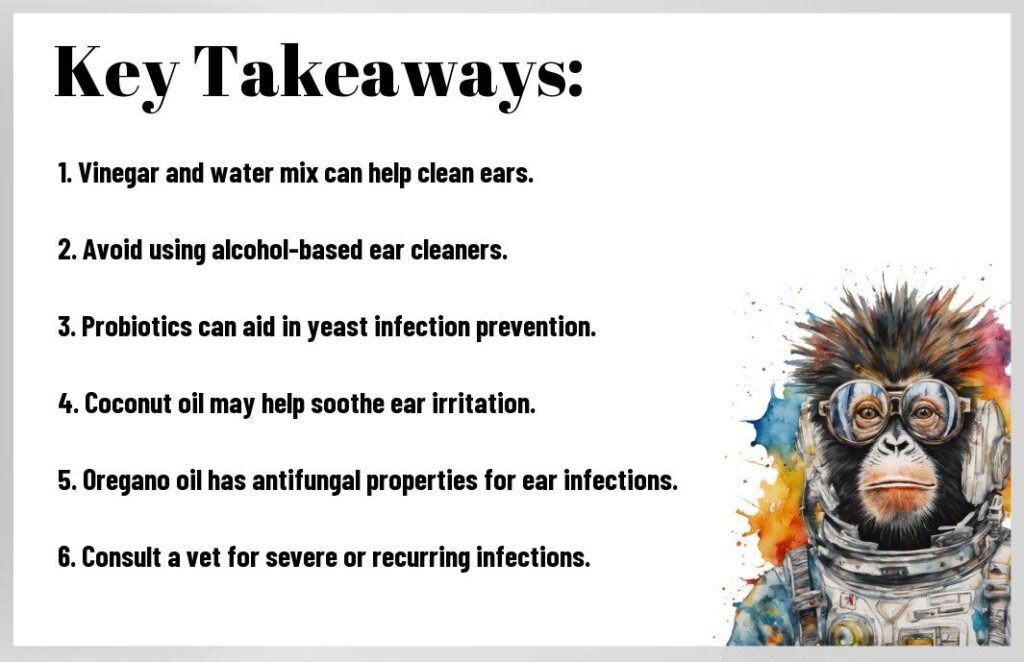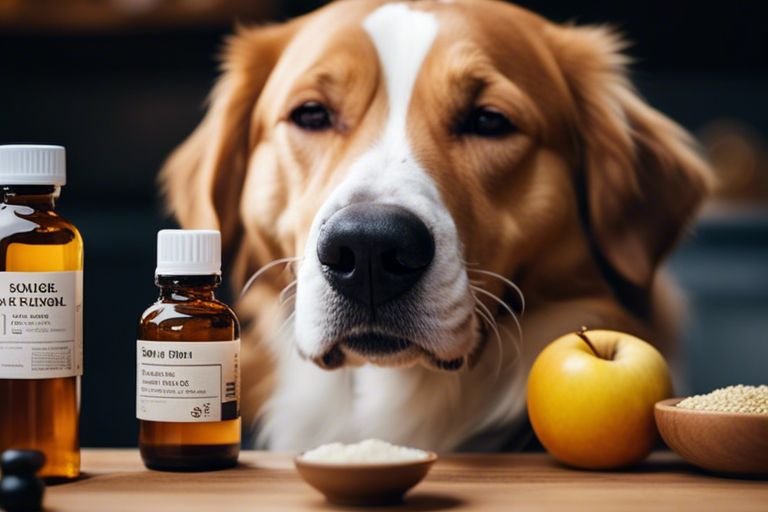Natural Remedies For Dog Ear Yeast Infections

You love your furry friend and want to keep them healthy and happy. If you’ve noticed your dog scratching their ears more than usual, they may be suffering from a yeast infection. In this informative blog post, you will discover natural remedies that can help soothe your dog’s discomfort and treat ear yeast infections effectively. By incorporating these gentle and safe remedies into your pup’s routine, you can promote their ear health and overall well-being.
Key Takeaways:
- Identify the symptoms: Before starting any treatment, it is important to correctly diagnose the presence of a yeast infection in your dog’s ears.
- Clean the ears: Regularly clean your dog’s ears with a gentle ear cleaner to remove excess wax and yeast buildup.
- Use natural remedies: Natural remedies like apple cider vinegar, coconut oil, or probiotics can help alleviate symptoms and fight the yeast infection.
- Avoid irritants: Be cautious of using harsh chemicals or cleaning agents that can further irritate your dog’s ears.
- Consult a vet: If the infection persists or worsens, it is important to seek advice from a veterinarian for proper diagnosis and treatment.

Causes and Symptoms of Dog Ear Yeast Infections
Common Causes of Yeast Infections in Dogs
On occasion, your furry friend may develop a yeast infection in their ears. This can be caused by a variety of factors, including moisture buildup in the ears from swimming or bathing, allergies, a weakened immune system, or even an underlying medical condition. Dogs with long, floppy ears are particularly prone to yeast infections as their ear shape can create a warm, moist environment ideal for yeast overgrowth.
Identifying the Signs and Symptoms of Yeast Infections
Symptoms of a dog ear yeast infection can vary, but common signs to watch out for include itching or head shaking, redness or swelling in the ear canal, a foul odor coming from the ears, and a dark discharge that resembles coffee grounds. If you notice your dog exhibiting any of these symptoms, it’s imperative to have their ears checked by a veterinarian to confirm a yeast infection diagnosis.
Infections
If left untreated, a dog ear yeast infections can lead to discomfort and pain for your furry companion. It’s crucial to address the infection promptly with the appropriate treatment to alleviate your dog’s symptoms and prevent further complications. By understanding the causes and symptoms of yeast infections in dogs, you can take proactive steps to keep your pet healthy and happy.
Conventional Treatment Options
Medications and Topical Creams
Topical medications and creams are commonly prescribed by veterinarians to treat dog ear yeast infections. These products often contain antifungal and antibacterial properties to help eliminate the yeast overgrowth in your dog’s ears. Applying these directly to the affected area can help alleviate symptoms and clear up the infection.
Potential Side Effects and Drawbacks
For some dogs, using medications and topical creams can come with potential side effects and drawbacks. It’s necessary to be aware of these possibilities when treating your dog’s ear yeast infection. Some dogs may experience skin irritation or increased discomfort when using these products. Additionally, there is a risk of the infection recurring if the underlying cause is not addressed.

Natural Remedies for Dog Ear Yeast Infections
Now, let’s explore some effective natural remedies for treating your dog’s ear yeast infections. Making some dietary changes and adding supplements to your dog’s diet can help boost their immune system and fight off the yeast overgrowth in their ears.
Dietary Changes and Supplements
The first step in combating your dog’s ear yeast infections naturally is by making changes to their diet. Consider switching to a high-quality, grain-free dog food that is low in carbohydrates, as yeast thrives on sugar. Adding supplements like probiotics and omega-3 fatty acids can also help balance your dog’s gut flora and strengthen their immune system to better fight off the yeast.
Herbal Remedies and Essential Oils
Oils such as tea tree oil and coconut oil have natural antifungal properties that can help combat yeast infections in your dog’s ears. Herbal remedies like calendula, mullein, and aloe vera can also soothe the irritation and inflammation caused by the yeast overgrowth. These natural remedies can be applied topically to your dog’s ears to provide relief and promote healing. Infections can be persistent, and it’s important to consult with a holistic veterinarian before using any herbal remedies or important oils on your dog’s ears. They can provide guidance on the proper dilution ratios and application methods to ensure the safety and effectiveness of these natural treatments.
Homeopathic Treatments and Aromatherapy
An effective homeopathic treatment for dog ear yeast infections is Pulsatilla, which can help alleviate the discomfort and itching associated with the infection. Aromatherapy using lavender or chamomile important oils can also have a calming effect on your dog and reduce stress, which can contribute to yeast overgrowth. These natural approaches can complement other treatments and support your dog’s overall well-being. Natural remedies offer a gentle yet effective way to treat your dog’s ear yeast infections without the use of harsh chemicals. By incorporating these holistic approaches into your dog’s care routine, you can help them find relief and prevent future recurrences of yeast infections in their ears.
Coconut Oil as a Natural Remedy
Many pet owners are turning to coconut oil as a natural remedy for treating dog ear yeast infections. Coconut oil is known for its antifungal and anti-inflammatory properties, making it a popular choice for addressing various health issues in dogs.
Antifungal and Anti-Inflammatory Properties
Antifungal: Coconut oil contains lauric acid, a medium-chain fatty acid that has natural antifungal properties. When applied to your dog’s ears, coconut oil can help combat the overgrowth of yeast that leads to infections. Additionally, coconut oil creates a protective barrier on the skin, preventing further infection.
How to Use Coconut Oil for Dog Ear Yeast Infections
Natural: To use coconut oil for treating your dog ear yeast infections, simply warm a small amount of coconut oil in your hands until it becomes liquid. Gently massage the oil into your dog’s ears, focusing on the affected areas. Make sure not to use too much oil, as it can lead to a greasy buildup in your dog’s ears. Anti-Inflammatory: Coconut oil also has anti-inflammatory properties, which can help soothe irritation and redness in your dog’s ears caused by the yeast infection. Regularly applying coconut oil can aid in relieving discomfort and promoting healing in your furry friend’s ears.

Tea Tree Oil and Other Essential Oils
Your How to Cure a Yeast Infection in a Dog’s Ear might involve exploring natural remedies like Tea Tree Oil and other vital oils. These oils are known for their potential antimicrobial properties and can be beneficial in managing and combating yeast infections in your dog’s ears.
Antimicrobial Properties and Benefits
Properties like Tea Tree Oil possess antimicrobial properties that can help fight off the yeast overgrowth in your dog’s ears. Tea Tree Oil, along with other vital oils such as Lavender and Chamomile, can provide soothing relief while combating the underlying cause of the infection. These oils can help reduce inflammation, itching, and discomfort associated with yeast infections, promoting healing and overall ear health for your furry friend.
Safe Use and Precautions for Dogs
Essential oils are potent and must be diluted before use on your dog. When using Tea Tree Oil or other vital oils for your dog’s ear yeast infection, always dilute them with a carrier oil like coconut oil to prevent skin irritation or sensitivity. Additionally, it’s vital to consult your veterinarian before using vital oils, as some oils can be toxic to dogs if ingested or used incorrectly. Always perform a patch test before applying any vital oil to your dog’s ears to ensure they do not have any adverse reactions.
Plus, be cautious with the amount of oil you use and the frequency of application to prevent any potential overdose or buildup of oils in your dog’s ears. Monitor your dog for any signs of discomfort or adverse reactions after using vital oils and discontinue use if any issues arise.
Apple Cider Vinegar and Other Natural Antifungals
Despite the discomfort and irritation that dog ear yeast infections can cause your furry friend, there are natural remedies that can help alleviate these symptoms. Apple cider vinegar is known for its antifungal properties and can be a valuable tool in combating yeast infections in your dog’s ears.
Acidic Properties and Effects on Yeast
On a molecular level, apple cider vinegar has acidic properties that can help create an environment in your dog’s ears where yeast struggles to survive. The acidity of the vinegar can help restore the natural pH balance of the ear, making it less hospitable for yeast to thrive.
How to Use Apple Cider Vinegar for Dog Ear Yeast Infections
Other than its antifungal properties, apple cider vinegar can also help soothe inflammation and itching in your dog’s ears. To use apple cider vinegar to treat a yeast infection, you can dilute it with water in a 1:1 ratio and gently apply it to your dog’s ears using a clean cloth or cotton ball. Make sure not to use it if the skin is broken or irritated as it can cause stinging.
A word of caution: do not use apple cider vinegar in your dog’s ears if they have any open wounds or sores, as it can be painful and exacerbate the issue. Always consult with your veterinarian before trying any new remedies or treatments to ensure they are safe and appropriate for your dog’s specific condition.

Preventing Future Yeast Infections
Regular Ear Cleaning and Maintenance
Preventing future yeast infections in your dog’s ears starts with regular ear cleaning and maintenance. By gently cleaning your dog’s ears on a routine basis, you can help remove excess wax and moisture that can contribute to yeast overgrowth. Use a veterinarian-approved ear cleaning solution and cotton balls to wipe the inside of the ear flap and the visible part of the ear canal. Avoid using Q-tips or inserting anything into the ear canal to prevent injury. Consistent ear care can go a long way in keeping yeast infections at bay.
Boosting Your Dog's Immune System
With a strong immune system, your dog is better equipped to fight off yeast infections. To boost your dog’s immune system, ensure they have a balanced diet rich in vitamins and minerals. Provide regular exercise to keep them physically healthy and mentally stimulated. Additionally, consider incorporating immune-boosting supplements such as probiotics or omega-3 fatty acids into their daily routine. A healthy immune system is key to preventing recurrent yeast infections and overall well-being for your furry friend.
Yeast infections in your dog’s ears can be uncomfortable and persistent if not properly addressed. By implementing preventive measures like regular ear cleaning and maintenance, as well as boosting your dog’s immune system, you can help reduce the likelihood of future yeast infections. Remember to consult your veterinarian for guidance on the best practices to keep your dog’s ears healthy and free from yeast infections.
Conclusion
With this in mind, it’s important to remember that natural remedies for dog ear yeast infections can be effective when used in conjunction with veterinary care. Always consult with your veterinarian before trying any new treatments to ensure they are safe and appropriate for your furry friend. By taking a holistic approach to your dog’s health and well-being, you can help prevent and manage ear yeast infections in a gentle and natural way.
Remember to observe your dog closely for any signs of discomfort or worsening symptoms, and don’t hesitate to seek professional advice if needed. By incorporating natural remedies such as apple cider vinegar, coconut oil, and probiotics into your dog’s ear care routine, you can help promote a healthy balance and support their overall wellness. Your dog will thank you for the love and care you provide!
FAQ
Q: What causes ear yeast infections in dogs?
A: Ear yeast infections in dogs are typically caused by an overgrowth of yeast, which can be triggered by factors such as moisture, allergies, a weakened immune system, or a buildup of wax in the ear canal.
Q: How can I prevent ear yeast infections in my dog?
A: To prevent ear yeast infections in your dog, you can regularly clean your dog’s ears, keep them dry, feed them a high-quality diet, and address any underlying allergies or health issues that may contribute to yeast overgrowth.
Q: What are the symptoms of a dog ear yeast infections?
A: Symptoms of a dog ear yeast infections may include redness, swelling, itching, discharge with a yeasty smell, head shaking, ear scratching, and pain or discomfort when the ears are touched.
Q: Can I use natural remedies to treat my dog ear yeast infections?
A: Yes, there are several natural remedies that can help treat a dog ear yeast infections, such as apple cider vinegar, coconut oil, probiotics, aloe vera, and herbal ear drops. These remedies can help reduce inflammation, fight off yeast, and promote healing in the ears.
Q: When should I take my dog to the vet for an ear yeast infection?
A: If your dog ear yeast infections is severe, recurring, or not improving with home remedies, it is important to take your dog to the vet for proper diagnosis and treatment. The vet may prescribe medication or recommend further testing to address the underlying cause of the infection.




